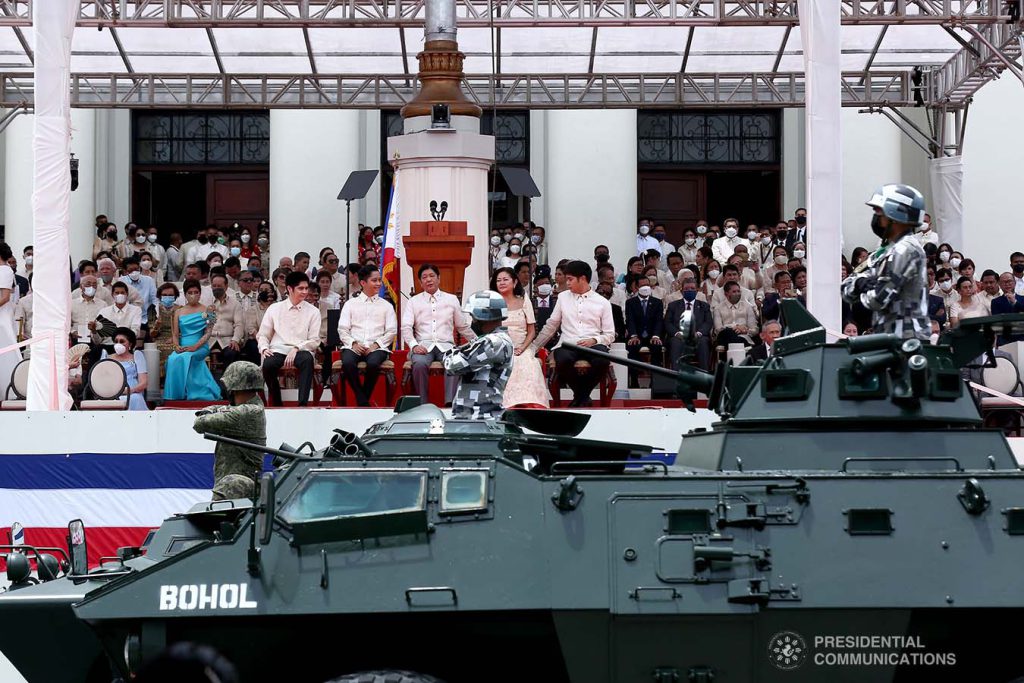Transparency and accountability in modernizing the military

President Ferdinand “Bongbong” Marcos Jr. at a military-civic parade held during his inauguration on Thursday, June 30, 2022. Photo from President Comminications Office.
By Manuel Mogato | Date 02-02-2024
Ferdinand Marcos Jr. has approved a very ambitious capability upgrade for the Armed Forces of the Philippines to cement the Philippines as a middle power in the region.
The revised third horizon of the 2013 modernization program would cost a whooping 2 trillion pesos spread over 10 years until 2034, beyond Marcos’ term as president.
Defense Secretary Gilberto Teodoro did not provide specific military platforms and equipment.
Still, the upgrade would certainly boost the country’s minimum credible defense as the government shifts from an internal defense force to an external defense.
Teodoro said the president has approved a plan that would give the defense and military establishments “an array of capabilities” aimed at enhancing maritime domain awareness, connectivity, and intelligence.
He said the priority would be given to C4ISTAR or the command, control, communications, computers, intelligence, surveillance, target acquisition and reconnaissance.
The main purpose of the C4ISTAR is to improve the military’s anti-access and area denial (A2AD) capabilities, which the country still lacks.
For this purpose, the Philippines would acquire several batteries of shore-to-ship missiles for the Marines and Army, positing them in the western part of the country facing the disputed waters in the West Philippine Sea.
The military has been detecting intrusions into the country’s 200-nautical mile exclusive economic zone (EEZ) and appeared helpless to stop illegal fishing and poaching by Chinese, Vietnamese, and Malaysian fishermen. Some foreign fishing fleets come close to about 30 nautical miles from the shore, competing with local fishermen using indigenous boats.
India has offered to supply Brahmos missiles for the Marines while the United States has been demonstrating the capabilities of its High Mobility Artillery Rocket System (HIMARS) during annual combined and joint Balikaan exercises.
Last year, the US demonstrated HIMARS capability by helping sink an old warship in the West Philippine Sea.
The Army has also expressed interest in acquiring the Brahmos and HIMARS to strengthen its territorial defense capability, shifting from counter-insurgency operations.
The Air Force was installing additional air defense radars to detect hostile aircraft 400 miles away from the shore and provide 100 percent coverage of the Philippine Air Defense Identification Zone (PADIZ).
However, in order to stop and interdict potential intrusions, the Air Force needs advanced multi-role fighters for air defense and air superiority.
The Air Force still chooses between the Swedish JAS 39 Gripen or the US F16 fighters. The US might also offer second-hand F16s, which is more affordable than a package of 12 brand-new F16s worth $2.4 billion.
The Philippine Air Force has only allocated $1.2 billion under the modernization program.
The integrated air defense system would also include communications and anti-air defense missiles to protect the radars.
For the Navy, additional guided missile frigates, corvettes, Off-Shore Patrol vessels, and two diesel-electric submarines to project power beyond the shores.
These would not only ensure “show the flag” operations but would establish a presence in the disputed waters.
Long-range maritime aircraft, anti-submarine planes, and helicopters would also be needed to patrol and protect the Philippines’ interests in the West Philippine Sea.
The acquisition projects would entail multi-year funding and soft loans from foreign governments through a memorandum of agreement to hasten the delivery of the equipment.
However, the Philippine government must raise its defense spending up to 2 percent of its GDP to afford the expensive modern equipment.
There was also a need to review the 2012 military modernization law because it does not give flexibility in acquiring weapon systems.
The most important in pushing for the capability upgrade is less intervention from political leaders which could result in corruption and irregularities in buying equipment.
Marcos has big plans for the military.
However, it must learn from past lessons done in the past administrations when modernization projects were clouded by political interests
Transparency and accountability would help a lot in realizing the ambitious military modernization projects.
The Philippines has to catch up with its neighbors to become a middle power in the region.
